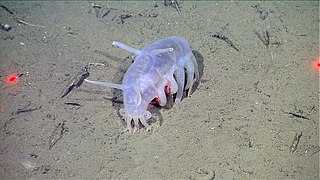
Sea cucumbers are echinoderms from the class Holothuroidea. They are marine animals with a leathery skin and an elongated body containing a single, branched gonad. Sea cucumbers are found on the sea floor worldwide. The number of holothurian species worldwide is about 1,717 with the greatest number being in the Asia Pacific region. Many of these are gathered for human consumption and some species are cultivated in aquaculture systems. The harvested product is variously referred to as trepang, namako, bêche-de-mer or balate. Sea cucumbers serve a useful role in the marine ecosystem as they help recycle nutrients, breaking down detritus and other organic matter after which bacteria can continue the degradation process.

Enypniastes is a genus of deep-sea sea cucumber. It is monotypic, being represented by the single species Enypniastes eximia. Due to its unique appearance, the species has been dubbed the headless chicken fish, headless chicken monster, and the Spanish dancer. It is also known as the swimming sea cucumber, and some are called the pink see-through fantasia.

Elasipodida is an order of sea cucumbers. They have numerous appendages, including conical papillae and leaf-like tentacles. Although many species are benthic, a number are pelagic, and may have their appendages modified to form sails or fins. Most members of the order inhabit deep-sea environments, such as the species of the genus Enypniastes.

Psychropotes is a genus of sea cucumbers in the family Psychropotidae. The members of this genus possess the ability to swim, although this is only facultative.

Psychropotes longicauda is a species of sea cucumber in the family Psychropotidae. It inhabits the deep sea where the adult is found on the seabed. The larva is pelagic and has an appendage shaped like a sail on its back which may enable it to move through the water.

Pelagothuriidae is a family of deep-sea swimming sea cucumbers. They are somewhat unusual in appearance, in comparison with other sea cucumbers, having numerous appendages, including conical papillae and leaf-like tentacles. Most of them are benthopelagic, which means that they are able to swim for a time from the bottom : the species Pelagothuria natatrix is the only true pelagic holothurian ; it looks like a jellyfish. Most members of the order inhabit deep-sea environments, like Enypniastes.
Ixorheis is a genus of parasitic alveolates in the phylum Apicomplexa.

Elpidiidae is a family of deep-sea sea cucumbers.

Elpidia is a genus of deep-sea sea cucumbers. Members are characterised by their rod-shaped spicules which each have two pairs of obliquely-placed horizontal arms and two vertical apophyses. There is a high degree of endemism in this genus with different species occupying different deep sea basins or regions.
Peniagone is a genus of deep-sea sea cucumbers in the family Elpidiidae. Peniagone wyvillii is the type species.
Peniagone vitrea is a species of deep-sea swimming sea cucumber in the family Elpidiidae. It is a detritivore and is found in the northern Pacific Ocean at abyssal depths. It was first described by the Swedish zoologist Hjalmar Théel in 1879, being one of the many deep sea animals discovered during the Challenger expedition of 1872–1876.

Johan Hjalmar Théel was a Swedish zoologist and university professor.
Ellipinion is a genus of deep-sea sea cucumbers in the family Elpidiidae. It was first described by the French marine biologist Edgard Hérouard in 1923.

Laetmogonidae is a family of sea cucumbers.

Synallactida is a rankless clade of sea cucumbers, but is referred to as an order. Taxa within Synallactida were previously classified in an order called Aspidochirotida, which was determined to be polyphyletic in 2017.

Cucumaria vegae, also known as tiny black sea cucumber or northern tar spot, is a species of sea cucumber. It was first described to science by Johan Hjalmar Théel in 1886 reporting on the sea cucumber specimens brought back by the Challenger expedition. Among these was the type specimen for this species, which was collected at Bering Island.

Pannychia moseleyi is a sea cucumber in the family Laetmogonidae. It was first described by Johan Hjalmar Théel in 1882. It can be up to 200 mm long and 40 mm wide. It occurs in the benthic zone at depths greater than 400 m.

Psychropotidae is a family of deep-sea swimming sea cucumbers. The geographic range of some psychropotids is very extensive at abyssal depths, whereas other species are found within more restricted ranges.

Benthodytes is a genus of sea cucumbers in the family Psychropotidae.
Psycheotrephes is a genus of sea cucumbers in the family Psychropotidae.














